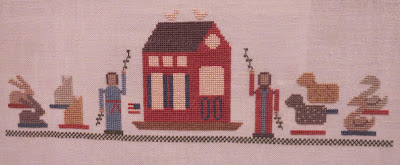It's getting dark now by 7:30pm, so I find that I am stitching in the evenings once again. All I have left is some back stitching and detail stitches; and this ark will be ready to roll away (it has wheels!)
I watch the birds most mornings for a couple of hours and count anywhere from 15 to 27 different kinds.
Lately I've seen a small group of Purple Finches.
It's very hard for me to tell male Purple Finches from House Finches.
But when a gal shows up and has a white eyebrow (on left), I know that it is a group of Purple Finches.
I am now seeing several Robins in the morning and evening.
I saw my first Fox Sparrow for the autumn.

Note the dark head, and the brown and white breast.
In comparison, the Song Sparrow has a lighter brown head with cream stripes, and cream and brown breast.
I had a male Lesser Goldfinch come by on Tuesday after not having seen one for well over a week.
This time of year he is much more colorful than the male American Goldfinches.
I also had one young Evening Grosbeak stop by momentarily.
I wish they were winter guests here, but they are just flying through.
I love their big thick seed-crushing bills.
I continue to have lots of Cedar Waxwings.
I expect as long as there are ripe berries in area, they will hang around.
I like it when they roost in trees close by...
...and I can get a good clear look at them.



















































